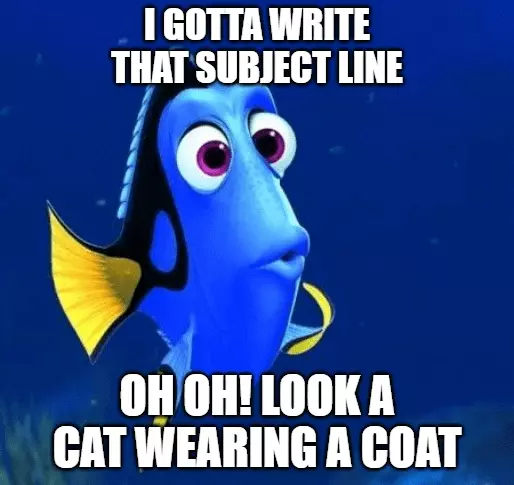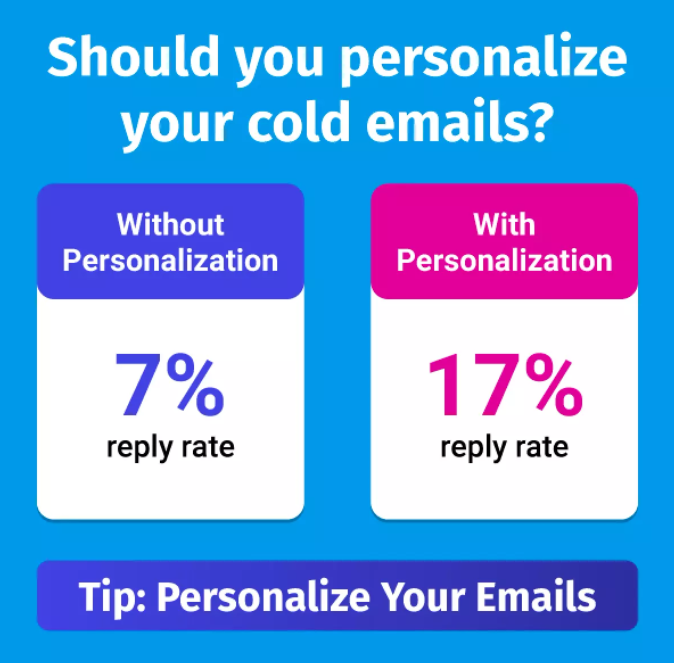Cold email outreach is one of the most popular strategies for generating leads and building backlinks.

Indeed, the average sales development rep sends 36.2 emails every day, making it the most-used tactic ahead of:
- Phone calls (35.9 per day)
- Voicemail messages (15.3 per day)
- Social media touches (seven per day)
But there’s a problem.
For all those cold emails, just one in four are ever opened. Clearly, the response rate is going to be even lower.
So is it a waste of time to write outreach email messages?
Absolutely not — we just need to get better at it!
What Is An Outreach Email?
An outreach email is the type of email sent during cold outreach campaigns, created with the goal of requesting a backlink, promoting a piece of content, or generating a new lead.
Cold email outreach is very different from newsletter-based email marketing, which is more about nurturing relationships with new and existing customers.
What Makes Outreach Emails So Important?
You’ve probably received a bunch of bad outreach email messages before. Emails like this one:
Generic copy; odd phrasing; no added value. Even the tone is wrong — it comes across as weirdly confrontational.
Chances are, you’ve received so many of those low-quality cold outreach emails, you’re starting to wonder if there’s any actual benefit to cold email outreach.
But the fact is, effective outreach emails are worth their weight in gold.
They can help you build relationships in any industry. In time, those relationships can lead to:
- Press coverage
- Content promotion
- Podcast appearances
- Guest post placements
- Influencer partnerships
- Interview opportunities
- Mutually beneficial business partnerships
Those things can help you reach new audiences, generate valuable backlinks, and potentially even drive sales.
It All Begins With Knowing Your Audience
If you’re going to run successful cold outreach campaigns, you’re going to need to master the art of writing highly targeted personalized emails.

The benefits of personalization are clear. For instance, Data Axle found that emails with personalized email subject lines see a 50% higher open rate than non-personalized emails.
Despite this, only a tiny proportion of emails — 2%, by Data Axle’s reckoning — actually employ personalization.
Without taking the time to personalize your copy, all you’re doing is sending the same boring cold email templates to hundreds or thousands of busy people.
Given that the average person is expected to receive 375 emails a day by 2025, the last thing you want is to create even more noise in a prospect’s email inbox.
To write personalized emails, you first need to truly understand your audience.
Obviously, you don’t need to be on first-name terms with them.
But you definitely need to take the time to find out who they are and what makes them tick.
Your goal at this stage is to craft a high-level overview of your prospects, often referred to as an ideal client profile or customer persona.
To build your outreach persona, answer the following questions about your prospects:
- Which industry do they work in?
- How big is their company?
- What is their geographic location?
- Do they have the authority to make a decision about buying your product, linking to your site, or booking you onto their podcast (or whatever goal you’re aiming to achieve through your outreach campaign)?
- What pain points do they experience at work?
- How would solving those pain points make their life better?
- What tone of voice or terminology is commonly used in their industry?
- Who are their main competitors?
Over time, you’ll naturally find additional tactics and techniques to personalize your email copy, so don’t be afraid to expand or update that list of questions as new opportunities emerge.
How To Write An Outreach Email That Converts
We understand the value of sending effective outreach emails.
And we know that personalization is key to improving email campaign success rates.
Now, let’s dive into seven practical steps to write outreach email messages that convert prospects:
1. Create Compelling Email Subject Lines
The subject line is arguably the single most important element of writing successful outreach emails.

In fact, research from OptinMonster suggests that nearly half of people on your email list will decide whether or not to open your email based solely on the subject line.
Of course, there’s no such thing as the “perfect” email subject line for every eventuality.
Context is everything, after all.
But it’s certainly possible to define the key components of an effective email subject, which you can use to tailor your subject lines to individual target audiences and campaigns.
Every time you write outreach email subject lines, strive to:
- Intrigue your prospect
- Use genuine language rather than sales or marketing speak
- Offer an accurate representation of your email content
- Incorporate personalized information (like a name, company, or pain point)
- Be clear and succinct
Want to learn more? Check out our guide to 27 common mistakes to avoid in cold email outreach subject lines.
2. Be Direct and Specific In What You Want
Always write outreach email messages with the attitude that you’re speaking to the busiest people on the planet.
That way, you’ll naturally keep your messages concise rather than rambling on unnecessarily.
Sure, you want to spend a sentence or two laying the groundwork and explaining who you are.
But after that, it pays to get to the point fast.
As a general rule, the perfect outreach email should be no more than four to six sentences long. That way, it’s short and easy to scan in a hurry.
To help structure your email copy, try using the inverted pyramid technique, whereby the most important elements appear at the top of the message.
3. Mention How It Benefits Them
No doubt, you’ve got a clear goal in mind when sending any cold email.
It could be to get a backlink to your latest blog post or to arrange an interview with a thought leader in your industry.
Or it could be as simple as getting a positive response from a potentially useful business contact.
Your prospect has their own goals.
When they decide to open an email, it’s because they want to find something of value — something that helps them overcome a specific problem or answers a common question.
As such, you need to explain what’s in it for them.
Don’t just ask them to link to your site or share your post on Twitter; give them something of value in return. That could be:
- Access to a new audience
- A free tool or useful piece of content
- The chance to connect with an expert in your niche (i.e. you)
4. Make Your Pitches Short
According to an analysis of eight billion email opens, the average amount of time people spend reading brand emails dropped from 13.4 seconds in 2018 to just 10 seconds in 2021.
Given that the average English silent reading speed is 238 words per minute, that means you’ve got no more than about 40 words — or a couple sentences — to get your point across before your prospects dial out.
So if your pitch isn’t succinct, your positive response rate is going to be tiny, because no one’s going to finish it.
5. Make Sure To Personalize Your Outreach Emails
I’ve already mentioned the power of personalization in subject lines.
And if your goal is to send effective, non-boring emails, the same thing applies to your body copy.
Never send an email that reads like an outreach template. Take the time to add details personalized to each prospect, and aim to be relatable. A little (well-intentioned) humor can go a long way here.

Of course, personalizing your email content isn’t as simple as sending hundreds of emails that are exactly the same.
It’s about more than just starting your message: “Hi, {first.name}.”
You need to do some serious research. And that takes time.
But there’s a solution — Postaga!
Postaga makes it quick and easy to create hyper-personalized email copy by pulling in articles and snippets, freeing you up to craft engaging icebreakers by:
- Utilizing humor
- Complimenting recipients
- Name-dropping mutual contacts
- Praising their recent achievements
- Referencing their blogs and social media content
6. End Your Outreach email With a Proper Sign-Off
Once you’ve written the perfect, hooky intro and gotten your pitch down persuasively and concisely, it’s time to sign off with an engaging call to action (CTA).
This is your opportunity to spell out exactly what you want your prospect to do next.
Because the last thing you want is to pique their interest with a compelling pitch, then leave them guessing.
Try:
- Asking a question that urges them to respond
- Requesting a meeting and including a Calendly link
- Including a link to download your latest piece of content or try out a free tool
7. Don’t Forget Follow-Up Emails
Last but not least, don’t overlook the importance of follow-up emails.
According to Backlinko, just 8.5% of outreach emails receive a response.
But emailing the same contact multiple times leads to double the responses.
Ultimately, it’s a numbers game.
While you don’t want to hound your prospects, the more follow-up emails you send, the more responses you’re going to receive.
However, there are a few golden rules to consider when creating new follow-up email templates:
- Don’t send follow-ups on weekends
- Always add context to your follow-up emails so the recipient doesn’t have to refer back to your initial email
- Never follow up during the holidays
- Use open and reply rate data to figure out the best cadence for follow-up emails
One final tip: don’t send too many follow-ups. Yesware research shows that response rates drop off for each additional email you send:
Honestly, if you haven’t got a reply after the fifth or sixth email, it’s probably time to move on.
Outreach Tips: Things You Should Never Do In Your Outreach Emails
1. Never Say The Wrong name
Sure, personalization is great.
But at the same time, it’s better to just use a generic “Hi there” than to call your prospect by the wrong name, or to accidentally refer to them as “{first.name}”.
Before you click Send, always check that the name in the email ID matches the prospect’s actual name.
Also, if you’ve done your research, it should be obvious if they prefer to go by “Andrew” or “Andy”.
2. Never Include Attachments
This is a life-changing outreach tip. The only time to send attachments in cold emails is when you don’t care about looking like a spammer (i.e. never).
Attachments look untrustworthy, and the recipient likely doesn’t know you. So why would they download your random pdf?
Instead, add hyperlinks to useful content and other information.
3. Never Make It All About You
A lot of cold emailers have a major case of main character syndrome. You’ll become the villain if you focus on yourself.
They bang on about themselves, their company, and their product, without referencing the most important person: the recipient.
Obviously, your “pitch” element of your email needs to be at least partly about you.
But the intro copy should be highly personalized to each prospect, so it’s clear they’re dealing with someone who’s done their research.
4. Never Send Poorly Formatted Emails
Messy emails are a major bugbear of mine.
This is one of those outreach tips we shouldn’t be giving out. But a lot of people do send messy emails. If I open an email and see the formatting is all over the place, I’m almost always going to click straight back to my email inbox without reading a single word.
And so will your prospects.
The same goes for spelling, punctuation, and grammar.
No one expects you to write like Hemingway, but at the very least you should use a tool like Grammarly to get the basics right.
In particular, make sure to:
- Not go overboard on special characters or bold/italicized text
- Double-check your spelling and grammar
- Speak about benefits rather than listing product features
- Keep your tone of voice polite and not overly casual
5. Never Include Multiple Call To Actions
Not including a call to action is a problem, but adding multiple CTAs can be just as bad. This is one of the most common mistakes in a call to action.
Simply put, every cold email you send should have one clear goal in mind.

It could be a content download, an email response, a meeting appointment, or something else entirely.
But if you ask people to take more than one action in a single email, you’ll only end up looking spammy or confusing your prospects.
It’s fine to have multiple goals for a single outreach campaign but leave additional CTAs for later emails, once you’ve already received a response and struck up a relationship. Learn how to perfect your cta by reading our in-depth guide on call to action.
Examples of Outreach Emails From Successful Campaigns
Now that we’ve clarified what to include (and exclude) from your cold emails, it’s time to take a look at five real-world examples of successful outreach emails.
To make this list as useful as possible, we’ve segmented the examples by the specific goals you’re looking to achieve.
1. Link Building Outreach Email Template
A strong backlink profile can make the difference between ranking on the first page of Google or languishing on page two (or even deeper).
Indeed, research from Backlinko revealed that the average result ranking at #1 on Google has 3.8 times the backlinks of the results at positions #2 – #10.
So it’s definitely in your interest to send the best possible link-building outreach emails.
From our experience, one of the most effective tactics is to find articles that link to your competitor’s content, then ask the publisher to link to your content instead.
This approach leverages the so-called skyscraper outreach technique, which involves:
- Finding a piece of content you want to out-rank (we’ll refer to this as the “old article”)
- Using a tool like Ahrefs to generate a list of all the sites linking to the old article
- Writing a newer, better-researched, more in-depth version of the old article
- Reaching out to the sites on your list and asking them to swap their link from the old article to your shiny, new article
It works so well because you’re not asking for much in return, but you’re providing obvious value in the form of an up-to-date article that’ll enhance their own content.
2. Guest Post Outreach Email Template
Yes, we all have had those dear sir emails trying to sell you spammy backlinks. Done well, guest blogging is another highly effective link-building tactic. A highly personalized cold email template separates you from the bad crowd.

But while it might seem like an easy sell — after all, you’re essentially giving away a piece of unique content free of charge — it’s important to note that high-authority websites might receive dozens of guest post requests a day.
So if your outreach email doesn’t cut through the noise, you’re not going to generate results from guest posting.
Your best bet here is to make it easy for the prospect to say “yes”.
Make it clear that you understand the types of content they like to publish and have the knowledge to create something their audience will love.
Don’t worry about bombarding them with ideas at this stage.
If they like the sound of your expertise, you can follow up with specific content pitches.
3. Influencer Outreach Email Template
According to Matter Communications, 61% of consumers are likely to trust recommendations from a friend, family member, or influencer on social media.
In contrast, just 38% are likely to trust recommendations from brands.
So influencer collaborations can be a powerful weapon in your marketing armory.
As with so much in the world of cold outreach, personalization is key to connecting with influencers.
Make it clear that you love their work and explain why they’d be a great fit for your campaign.
4. Podcast Outreach Email Template
As of 2021, 57% of US consumers had listened to at least one audio podcast.
What’s more, research from ABC discovered that people who had listened to a podcast in the previous week listened to an average of six episodes and four different series.

In short, landing a guest appearance of the right podcast can get you in front of a large and highly engaged audience.
But again, high-profile podcast hosts receive tons of these requests every single day, so make it clear:
- Why you’d be a great fit for their podcast
- What you want to speak about
- Why you’ve got the expertise to speak on those topics
5. Product Promotion Outreach Email Template
Nine in ten consumers read reviews before making a purchase, so the more positive, timely reviews you can acquire, the better.
But unless you’re the market leader in your niche, you can’t expect to generate tons of reviews organically (i.e. without any effort on your part).
When you find publishers who’ve reviewed your competitors’ products or services, reach out and ask them to consider reviewing yours as well.
Be sure to spell out what your product does and how it helps their audience, and offer them a free trial or account so they can try it out.
How Long Should Your Outreach Email Be?
When it comes to cold email outreach, size definitely matters.
Specifically, your emails should be short — around four to six sentences is perfect.
As for word count, data from Boomerang suggests that the sweet spot — at least from a response rate perspective — lies between 50 and 125 words.
Don’t treat this as a hard-and-fast rule; as you can see, there’s only a small drop-off from 100 – 200 words.
But whenever you write an outreach email, you should always strive to cut out unnecessary information and wasted words.
To Wrap It All Up

Given the volume of terrible cold outreach emails we all receive, you’d think writing good outreach emails was like cracking the Enigma code.
In reality, it’s easy (as long as you’ve got the right tools for the job).
Effective cold outreach is simply a matter of:
- Researching your prospects
- Understanding how you can add value to them
- Personalizing your email copy
- Being clear about the action you want them to take
- Following up within a couple days if you don’t receive a response
Do that consistently and I guarantee your reply rate will increase.
Free 14-Day Trial
Start building relationships now with your fully-featured 14-day trial!
How We Compare
Terms | Done-For-You Terms | Privacy | Write For Us | Press
© 2025 Postaga. All Rights Reserved. Made with 
